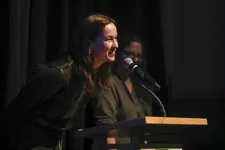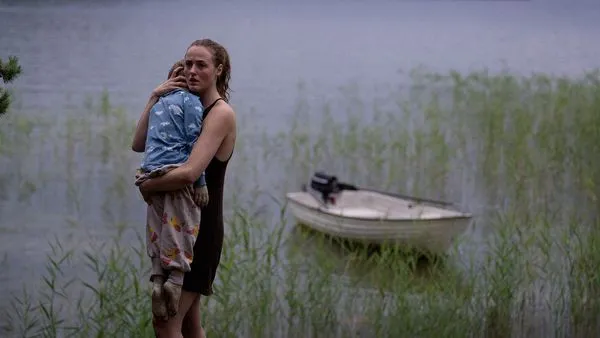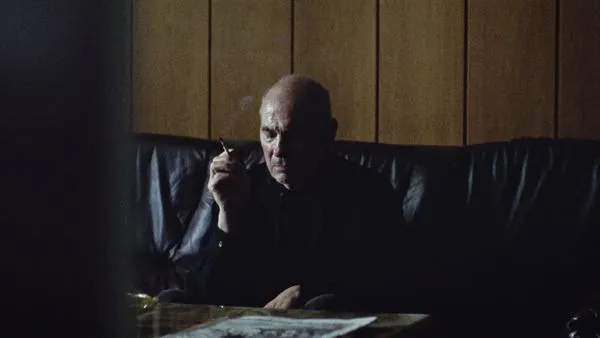Thea Hvistendahl’s Handling The Undead may feature zombies of sorts but they are at their most meditative and melancholic in a story that is focused on the nature of grief and letting go. Adapted by Let The Right One In’s John Ajvide Lindqvist from his own book, the film offers a triptych of stories that unfold after the hot Oslo summer is rocked by a strange event that sees the dead return from their graves. A woman (Bente Børsum) who has just laid her partner (Olga Damani) to rest finds her back at home not long after leaving the funeral parlour, while an accident leaves David (Anders Danielsen) and his young family facing dread and uncertainty. In the most moving story, Anna (current Nordic hot property Renate Reinsve) and her father Mahler (Bjørn Sundquist) try to help her son whose death, the buzzing flies suggest, was quite some time ago.
The film has been busy making its way around the festival circuit, since it premiered in Sundance, where Peter Raeburn’s impressive and nuanced score won a Special Jury prize and won four Amanda Awards, the Norwegian Oscar equivalent. Handling The Dead’s Latest stop off was Thessaloniki International Film Festival, where we caught up with Hvistendahl to chat about it.
When I spoke to your composer Peter Raeburn earlier in the year, he said when you came to him your brought images with you of how the feel of the film was going to be and I wondered if you could tell me a bit about your process when you’re preparing.
Thea Hvistendahl: I get the feeling of how I want the film to be and then I usually go and search for images or I have some in mind that will illustrate that feeling. The imagery and music are very important for me when designing the film and making the script able to be told in a certain way. I listened to a lot of music while I was working on the screenplay so when I first talked to Peter, I already had quite a lot of ideas about the mood and the atmosphere and the goal was kind of to make something that was gonna be both emotional and and unsettling at the same time and I couldn't find that many references that would make you both cry and be scared.
When you talk about images, is it classical paintings or more film imagery or stuff you might find in a magazine?
TH: A lot of times it's film frames but there's also some classical paintings and photography.
Peter also said you didn’t really have a temporary music track for the film, which is quite unusual.
TH: We tried to have as little as possible because I feel like the minute you start to use a lot of temp music, you fall in love with those pieces. I find that if you go to a composer and just say, “I want this but try to make it just a little bit different”, then that doesn't feel so creative.
He said you encouraged him to push himself further. Do you try to push yourself out of your comfort zone as well?
TH: If I stay in the comfort zone then it kind of gets less interesting and I don't work as hard and it's not as much fun. I feel like also, with the music for instance, it's like when we're in the edit and at one point the film kind of becomes its own person. So it's very clear when you put down the wrong music, that it doesn't work or the film kind of wants to be what it is. So then you just have to try different variations until it kind of sits right. With music it's hard because you don't know what you're looking for, I think, until you get it. In this project Peter was amazing because he made a sketch for us before we went into shooting. We used that sketch a lot when we were out filming, so me and the DP and the dolly grip were all listening to it on our headphones - so that was very convenient. Then afterwards, when we were doing the edit, that sketch didn't fit any more because it was too big and that’s always interesting.
This is a film that's built on silence as well and negative space, both sound-wise and visually. How did you settle on the spare attitude because it’s a film of contradictions in the sense that it's very quiet but then when the sound design and scoring comes in, of course, it's exceptionally noticeable. I think it's part of the ambivalence of your film which is what makes it so successful in a way.
TH: So the idea was mainly that because there are three different storylines that you follow and they're all in huge pain or grief from the beginning of the film, I felt that we can't really force the audience to to feel with them the whole time. And I also wanted it, as I said, to be dreadful, so it was how to do both without tiring out the audience with the emotions from the beginning of the film. And because it's three stories, it’s also a thematic thing that binds them together and drives the film. I wanted it to be meditative and poetic rather than a full-on and saying, “You have to think this, and this”. I wanted there to be space for the audience to put themselves into the film and reflect on their own lives and their own experiences.
 |
| Thea Hvistendahl in Sundance: 'If I stay in the comfort zone then it kind of gets less interesting and I don't work as hard and it's not as much fun' Photo: Courtesy of Sundance Institute |
So there had to be a lot of room for the audience both visually and sonically. You don't force them or feed them all the time, so there's room for them to also figure out what's happening in the story. How all the relationships are is not really explained, so you have to kind of puzzle it out, a little bit at least in the beginning.
I like silence because you can tell so much. Also an expectation in horror or zombie films is that there's a lot of screaming. But I feel like, if you take this premise seriously, if you could get your loved one back, you wouldn't want to scare them away, because I think that when you lose someone you love, everyone wants them to come back and it's almost hard to believe that they won't come back. So if they came back, I think that people in bereavement would kind of want to embrace that moment instead of being frightened by it because it's everything they want.
Also a lot of the silence comes from the fact I wanted to enhance how they are all very isolated in their grief and it's so hard to talk. So, in many ways, it came naturally and also from my intention that there was supposed to be a lot of space for the audience.
You’re quite young, so I hope you haven’t had to experience too much grief in your life yet. So did it feel daunting to take on this big concept?
TH: I think it was quite a gradual process because the book is much wider in scope and there are some other elements there and it's tackling the return of the dead in different ways but it was too big. While I was working on the script, I realised that I was mostly interested in a premise that would be more like, what if you got your biggest wish fulfilled? How would that look? And then gradually it moved into grief. I haven't experienced it, but I think it was more for me about not only grieving the dead, but a lot of people that I know also have that grief when they cannot move on from what has been in the past. It kind of tears them apart if they can't let go of the bad stuff that has happened or relationships that have been bad. So I thought of it in many different ways.
Then I did a lot of research on grief. I spoke to a lot of people who had lost people they loved and I spoke to grief counsellors and I read a lot of literature. I also did a lot of research on death with funeral directors. Birth and death are the two most natural things in life, and it happens every day and it’s part of our lives, but still it can feel so life-changing and devastating.
This is a pretty ambitious project for a first-time filmmaker, especially because it's a triptych, so you're basically doing three films in one in effect, especially because these stories are very self-contained. Did you face any specific challenges especially as this was your first film?
TH: I think the biggest challenge was for me working with the script because it took a lot of time to get it where I wanted it to be and to make it work because it had three different storylines and how could I connect them. It was hard to find references because the storylines don't intersect. So it was quite daunting but then I found a very good script consultant and she helped me a lot.
You also ended up with a very strong cast, but I gather that you cast Renata Reinsve and Anders Danielsen Lie before they were both in The Worst Person In The World.
TH: I got the rights for this project in 2019 and then we were maybe going to make it with Netflix in 2019. So that would have been quite different because it was a very different script. But then I already cast most of the cast back then except for Renata, because she was pregnant at the time, but I didn't find anyone for her role and then I cast her just before The Worst Person In The World came out, so I had no idea that they would be so huge. That was, of course, amazing. But Norway is very small, so I knew all of them and had already worked with some of them a little bit so they were just very supportive. I also felt very happy that they trusted me to come on board. I think that it probably also helped that it was an adaptation of a Lindqvist novel because everyone loves Let The Right One In.
I presume now you're thinking about future projects. I wouldn't know from this film if you would go in a genre direction or a more dramatic one because there are so many facets to Handling The Undead.
TH: So the projects I'm working on are all a little bit different but I would say that most of them are psychological dramas but with a genre element, either a little bit of sci-fi or thriller.
- Read what Peter Reaburn told us about collaboration and framing his award-winning score


























